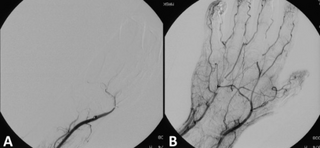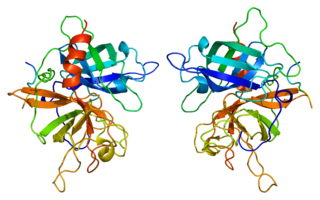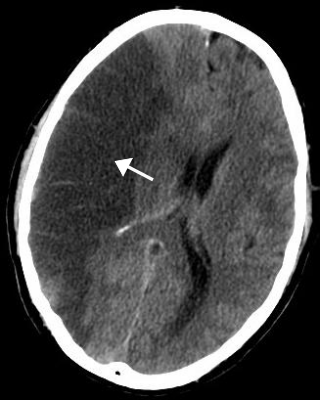Related Research Articles

Thrombolysis, also called fibrinolytic therapy, is the breakdown (lysis) of blood clots formed in blood vessels, using medication. It is used in ST elevation myocardial infarction, stroke, and in cases of severe venous thromboembolism.

Tissue-type plasminogen activator, short name tPA, is a protein that facilitates the breakdown of blood clots. It acts as an enzyme to convert plasminogen into its active form plasmin, the major enzyme responsible for clot breakdown. It is a serine protease found on endothelial cells lining the blood vessels. Human tPA is encoded by the PLAT gene, and has a molecular weight of ~70 kDa in the single-chain form.

Stroke is a medical condition in which poor blood flow to the brain causes cell death. There are two main types of stroke: ischemic, due to lack of blood flow, and hemorrhagic, due to bleeding. Both cause parts of the brain to stop functioning properly.

Desmoteplase is a novel, highly fibrin-specific "clot-busting" (thrombolytic) drug in development that reached phase III clinical trials. The Danish pharmaceutical company, Lundbeck, owns the worldwide rights to Desmoteplase. In 2009, two large trials were started to test it as a safe and effective treatment for patients with acute ischaemic stroke. After disappointing results in DIAS-3, DIAS-4 was terminated, and in December 2014 Lundbeck announced that they would stop the development of desmoteplase.
Eve Cordelia Johnstone CBE FRCP FRCPE FRCPGla FRCPsych FMedSci FRSE is a Scottish physician, clinical researcher, psychiatrist and academic. Her main research area is in the field of schizophrenia and psychotic illness. She is Emeritus Professor of Psychiatry and Honorary Assistant Principal for Mental Health Research Development and Public Understanding of Medicine at the University of Edinburgh. She is best known for her 1976 groundbreaking study that showed brain abnormalities in schizophrenic patients compared to a control group.

Intracerebral hemorrhage (ICH), also known as hemorrhagic stroke, is a sudden bleeding into the tissues of the brain, into its ventricles, or into both. An ICH is a type of bleeding within the skull and one kind of stroke. Symptoms can vary dramatically depending on the severity, acuity, and location (anatomically) but can include headache, one-sided weakness, numbness, tingling, or paralysis, speech problems, vision or hearing problems, memory loss, attention problems, coordination problems, balance problems, dizziness or lightheadedness or vertigo, nausea/vomiting, seizures, decreased level of consciousness or total loss of consciousness, neck stiffness, and fever.

Cerebral infarction is the pathologic process that results in an area of necrotic tissue in the brain. It is caused by disrupted blood supply (ischemia) and restricted oxygen supply (hypoxia), most commonly due to thromboembolism, and manifests clinically as ischemic stroke. In response to ischemia, the brain degenerates by the process of liquefactive necrosis.
Malcolm Macleod is a Scottish neurologist and translational neuroscientist.

Eliprodil is an NMDA antagonist drug candidate which selectively inhibits the NR2B (GLUN2B) subtype NMDA receptor at submicromolar concentrations. Eliprodil failed a Phase III clinical trial for the treatment of acute ischemic stroke in 1996, sponsored by Synthélabo Recherche.
Proteases are in use, or have been proposed or tried, for a number of purposes related to medicine or surgery. Some preparations involving protease have undergone successful clinical trials and have regulatory authorization; and some further ones have shown apparently useful effects in experimental medical studies. Proteases have also been used by proponents of alternative therapies, or identified in materials of traditional or folk medicine. A serine protease of human origin, activated protein C, was produced in recombinant form and marketed as Drotrecogin alfa and licensed for intensive-care treatment of severe sepsis. It was voluntarily withdrawn by the manufacturer in 2011 after being shown to be ineffective.
The ABCD2 score is a clinical prediction rule used to determine the risk for stroke in the days following a transient ischemic attack (TIA, a condition in which temporary brain dysfunction results from oxygen shortage in the brain). Its usefulness was questioned in a 2015 review as it was not found to separate those who are at low from those who are at high risk of future problems. A high score correctly predicted 87% of the people who did have a stroke in the following 7 days but also many people who did not have problems.
Interventional neuroradiology (INR) also known as neurointerventional surgery (NIS), endovascular therapy (EVT), endovascular neurosurgery, and interventional neurology is a medical subspecialty of neurosurgery, neuroradiology, intervention radiology and neurology specializing in minimally invasive image-based technologies and procedures used in diagnosis and treatment of diseases of the head, neck, and spine.
A microinfarct is a microscopic stroke generally ranging between 0.1 millimeter and 1 millimeter in size. Microinfarcts can be found in 25-50% of all elderly deceased persons. Microinfarcts may be the second most important cause of dementia, after Alzheimer's disease.
Carol Elspeth Goodeve Brayne CBE is a British academic and the Professor of Public Health Medicine at the University of Cambridge and Chair of Wellcome's Population and Public Health Review Group. She is Director of the Cambridge Institute of Public Health. She is a special advisor for the Royal College of Physicians and a senior investigator at the National Institute for Health Research (NIHR).
Catherine Sudlow is a British neurologist. She is a professor of Neurology and Clinical Epidemiology and Head of the Centre for Medical Informatics at the Usher Institute of Population Health Sciences and Informatics at the University of Edinburgh. She is the Chief Scientist of UK Biobank, and an honorary Consultant Neurologist in the Division of Clinical Neurosciences in Edinburgh.

Irene Mary Carmel Tracey is Vice-Chancellor of the University of Oxford and former Warden of Merton College, Oxford. She is also Professor of Anaesthetic Neuroscience in the Nuffield Department of Clinical Neurosciences and formerly Pro-Vice-Chancellor at the University of Oxford. She is a co-founder of the Oxford Centre for Functional Magnetic Resonance Imaging of the Brain (FMRIB), now the Wellcome Centre for Integrative Neuroimaging. Her team’s research is focused on the neuroscience of pain, specifically pain perception and analgesia as well as how anaesthetics produce altered states of consciousness. Her team uses multidisciplinary approaches including neuroimaging.
Very low cerebral blood volume (VLCBV) is a measurement of hemorrhagic transformation degree in the tissue surrounding the lesion in strokes. It is counted as one of the penumbral imaging procedures along with less commonly used methods such as diffusion-weighted imaging (DWI). These are used to predict if there is going to be a hemorrhage after the treatment by tPA. In advanced centers, this measurement helps with using tPA beyond the standard time limit without risk of hemorrhage.
Philip Michael Bath is a British clinician scientist. He is Stroke Association Professor of Stroke Medicine at the Stroke Trials Unit within the University of Nottingham. He specialises clinically in stroke and academically has established large-scale trials in treating and preventing stroke. Bath worked as a junior doctor before specialising in general medicine, stroke and hypertension. He is an Honorary Consultant Physician at Nottingham University Hospitals NHS Trust. He has spent his academic career at St George's, University of London, King's College London and University of Nottingham.
David John Werring is a British physician, neurologist, and academic specialising in stroke. He is professor of Neurology at the UCL Queen Square Institute of Neurology and current head of Stroke Research Centre and the department of Brain Repair & Rehabilitation at UCL.
Luca Saba is an Italian radiologist and neuroradiologist. He has made contributions in the field of imaging for the detection and characterization of vulnerable plaque and the identification of the causes of stroke. He is also the author of both American. and European consensus documents on this matter.
References
- 1 2 3 4 5 6 7 'WARDLAW, Prof. Joanna Marguerite', Who's Who 2017 , A & C Black, an imprint of Bloomsbury Publishing plc, 2017; online edn, Oxford University Press, 2016; online edn, Nov 2016 accessed 4 Nov 2017
- 1 2 3 4 5 "Joanna Wardlaw". Edinburgh Research Explorer. The University of Edinburgh.
- 1 2 3 4 5 6 7 "Prof. Dr. Joanna Marguerite Wardlaw". AcademiaNet. Retrieved 5 November 2017.
- ↑ Marguerite, Wardlaw, Joanna (1994). "Imaging and treatment of acute ischaemic stroke : the application and verification of non-invasive imaging techniques in the investigation and treatment of acute ischaemic stroke". hdl:1842/20860.
{{cite journal}}: Cite journal requires|journal=(help)CS1 maint: multiple names: authors list (link) - ↑ "Inpatient Information: The Institute of Neurological Sciences, Queen Elizabeth University Hospital, Glasgow". Neurology in NHS Greater Glasgow and Clyde. Retrieved 5 November 2017.
- 1 2 "Joanna-Wardlaw". Scottish Imaging Network: A Platform for Scientific Excellence. Retrieved 5 November 2017.
- ↑ "New SINAPSE Director: Prof Alison Murray". Scottish Imaging Network: A Platform for Scientific Excellence. Retrieved 5 November 2017.
- ↑ "Women in medicine: Joanna Wardlaw and Marie Curie". Royal College of Physicians. 3 October 2017. Retrieved 5 November 2017.
- ↑ "Professor Joanna Wardlaw CBE FRSE FMedSci". The Academy of Medical Sciences. Retrieved 5 November 2017.
- ↑ "Professor Joanna Marguerite Wardlaw CBE, FRSE, FMedSci". The Royal Society of Edinburgh. Retrieved 5 November 2017.
- ↑ Wardlaw, Prof. Joanna Marguerite. Oxford University Press. doi:10.1093/ww/9780199540884.013.286483. ISBN 978-0-19-954088-4.
{{cite book}}:|work=ignored (help) - ↑ "No. 61450". The London Gazette (Supplement). 30 December 2015. pp. N8–N10.
- ↑ "CBE for Professor Joanna Wardlaw". Centre for Clinical Brain Sciences. The University of Edinburgh. January 2016. Retrieved 5 November 2017.
- ↑ "Professor Joanna Wardlaw receives the European Stroke Organisation Presidential Award 2017". Edinburgh Neuroscience. The University of Edinburgh. 22 May 2017. Retrieved 5 November 2017.
- ↑ Wardlaw, Joanna. "Prizes". Edinburgh Research Explorer. The University of Edinburgh. Retrieved 10 March 2020.